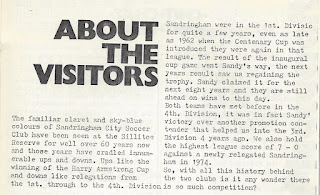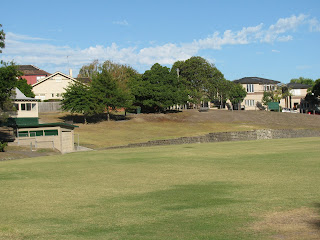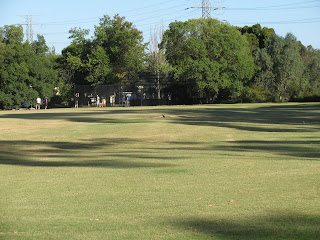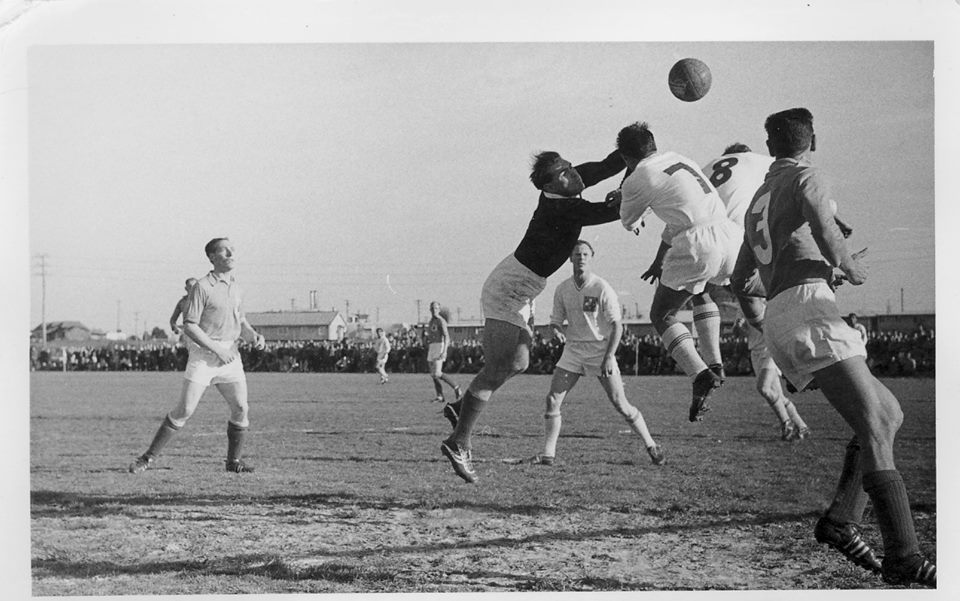First, a photo of the German team from the junior/reserves edition of the 1958 Laidlaw World Cup.
Back Row: Werner Klein, Werner Bormann, Matze Landherr, Ralf Eggert, Franz Marth, Guenter Weiland, Guenter Gerick.
Front Row: Bodo Bormann, Kurt Goettlicher, Erich Bartkowiak, Heinz Duecker.
Your 1994 VPL Champions - Preston Lions. From the short-lived Shoot Australia.
Frank Juric, also from Shoot Australia. Shoot Australia was 4 or 8 pages of Aussie content tacked into the middle of the regular UK edition of Shoot! magazine.
Wynton Rufer, from a proper vintage UK Shoot!
Two class acts, Milan Ivanovic and Josip Biskic. From Shoot Australia.
Mark Bosnich answers some questions for Shoot! And disses Billy Ray Cyrus.
Coin toss before a Laidlaw World Cup clash featuring Germany at Olympic Park. In the background is the Eastern Stand before it had a roof put on it.
Craig Johnston, about to surf for England. From the Classic Headliners section of 90 Minutes magazine.
And the final picture is also another 90 Minutes Classic Headliner:
R.I.P. Johan Cruyff 1947-2016
(Click on images to enlarge)
Home of the Australian Football Library and the occasional thoughts about local soccer
Tuesday, 29 March 2016
Friday, 25 March 2016
Mini Club Histories
The following pocket club histories are taken from the "About the Visitors" section of Moorabbin City Matchday programmes from between 1978-1981.
Caulfield City:
Clayton:
Corio:
Essendon Triestina:
Ferntree Gully:
Frankston Pines:
Geelong:
Hamlyn Rangers:
Hawthorn Citizens:
Karingal:
Keysborough:
Monash University:
Mornington:
North Dandenong:
Nunawading City:
Ringwood United:
Rosebud:
Sandringham City:
Sunbury United:
Werribee City:
Some are still around, some of these clubs have died, some changed their names and some merged or amalgamated with others.
(Click on images to enlarge)
Caulfield City:
Clayton:
Corio:
Essendon Triestina:
Ferntree Gully:
Frankston Pines:
Geelong:
Hamlyn Rangers:
Hawthorn Citizens:
Karingal:
Keysborough:
Monash University:
Mornington:
North Dandenong:
Nunawading City:
Ringwood United:
Rosebud:
Sandringham City:
Sunbury United:
Werribee City:
Some are still around, some of these clubs have died, some changed their names and some merged or amalgamated with others.
(Click on images to enlarge)
Wednesday, 9 March 2016
Lies, Incompetence and Racism, Football Admin Has It All
The FFV has once again undertaken the annual clearing out of the records of tribunal cases and appeals from it's website. For an organisation that claims transparency as one of it's core values, it's an action that opposes that aim.
There is apparently the opportunity to request past determinations with a phone call, but if that's anything like how they handle emails (and promises made in them) then don't hold your breath awaiting a reply.
The first game I attended this year was the W-League Grand Final. It was a great day, fine weather, good game, right result for a Melburnian with one notable black mark. In an act of incompetence that you would think should no longer be possible, the presentation stage was erected with it's back to the only parts of the ground open to spectators. When patrons should have been cheering for the women who had just completed a brilliant season, they were instead booing the idiots that were treating them with disdain.
With the game being filmed from the western stand, spectators were restricted to the eastern and southern parts of AAMI Park, bar a single bay of the northern end reserved for the Sydney FC active support. That is an acceptable arrangement, ensuring a solid crowd in the background of the telecast. When it comes to the presentation though, surely portable cameras could have been used to film it with the stage set up to allow the thousands of people who had stayed back for 20 or so minutes to witness it? Many would have probably left upon the final whistle had they known they were not welcome.
Would you be surprised if the idiots responsible were to one day wonder why more people don't go to games? I wouldn't.
Thanks to the great work of Paul Mavroudis in creating an archive of the Studs Up! fanzine, some historic gems have been unearthed. None more so than this account of an interview with former Soccer Australia board member George Negus on a Brisbane radio station:
Negus and David Hill pushed for the de-ethnicising of the NSL, and it is in their vision that the NCIP was introduced. Next time someone tries to tell you those policies were only about broadening the game's reach and not in any way racist, reflect on the words above.
It's my understanding that not employing someone on the basis of ethnicity is discrimitaion, of a racist variety. I'm not sure how George could spin it around to claim it isn't. He clearly states the thick accent of Matic is a deal-breaker and that his credentials and merits are therefore irrelevant.
In case you are not sure, these are some of the rules:
A Balkans accent is un-Australian.
British and Irish accents are Australian. These people are even more Australian than those born here to ethnic parents from places other than the UK and Ireland.
Once you grasp the importance of these rules you can see why unless the White Australia Policy is restored, the NCIP must strictly be adhered to.
(Click on images to enlarge)
There is apparently the opportunity to request past determinations with a phone call, but if that's anything like how they handle emails (and promises made in them) then don't hold your breath awaiting a reply.
The first game I attended this year was the W-League Grand Final. It was a great day, fine weather, good game, right result for a Melburnian with one notable black mark. In an act of incompetence that you would think should no longer be possible, the presentation stage was erected with it's back to the only parts of the ground open to spectators. When patrons should have been cheering for the women who had just completed a brilliant season, they were instead booing the idiots that were treating them with disdain.
With the game being filmed from the western stand, spectators were restricted to the eastern and southern parts of AAMI Park, bar a single bay of the northern end reserved for the Sydney FC active support. That is an acceptable arrangement, ensuring a solid crowd in the background of the telecast. When it comes to the presentation though, surely portable cameras could have been used to film it with the stage set up to allow the thousands of people who had stayed back for 20 or so minutes to witness it? Many would have probably left upon the final whistle had they known they were not welcome.
Would you be surprised if the idiots responsible were to one day wonder why more people don't go to games? I wouldn't.
Thanks to the great work of Paul Mavroudis in creating an archive of the Studs Up! fanzine, some historic gems have been unearthed. None more so than this account of an interview with former Soccer Australia board member George Negus on a Brisbane radio station:
Negus and David Hill pushed for the de-ethnicising of the NSL, and it is in their vision that the NCIP was introduced. Next time someone tries to tell you those policies were only about broadening the game's reach and not in any way racist, reflect on the words above.
It's my understanding that not employing someone on the basis of ethnicity is discrimitaion, of a racist variety. I'm not sure how George could spin it around to claim it isn't. He clearly states the thick accent of Matic is a deal-breaker and that his credentials and merits are therefore irrelevant.
In case you are not sure, these are some of the rules:
A Balkans accent is un-Australian.
British and Irish accents are Australian. These people are even more Australian than those born here to ethnic parents from places other than the UK and Ireland.
Once you grasp the importance of these rules you can see why unless the White Australia Policy is restored, the NCIP must strictly be adhered to.
(Click on images to enlarge)
Sunday, 6 March 2016
Grounds of the Past: MacDonald Reserve, Hawthorn East
In another case of it's hard to believe now, humble MacDonald Reserve (now known as Burke Road South Reserve, previously also known as Hawthorn South Reserve) hosted Victorian State League football as the home of Wilhelmina in the late 1950's and early 1960's.
The ground currently has no car park of it's own. There is very limited street parking on Sinclair Avenue. There have been many changes alongside the the ground since that time, which can be appreciated when we look at the Melways map from that era.
To the north, the drive in theatre became the Coles complex at Tooronga Village. The brickworks are long gone, and to the south Carroll Crescent disappeared to make way for the South Eastern Freeway. The majority of football patrons attending games would have come via trams down Burke Road or from the Gardiner train station.
The facilities are sparse. When I visited, cricketers using the nets at the south eastern end parked on the street and had no rooms to change in. The only structures on the site are a storage shed at the north eastern end, and another building further up the hill from it, which may have been the changing rooms when the ground was a VSL venue.
The quaint building sits near the storage shed, but it may also be that the current storage shed was even the changing room back then.
The view across the pitch looking from the east to the west. Behind the trees lies Gardiner's Creek and the Monash Freeway.
With it's lack of amenities, it's the hill on the Sinclair Avenue side that would have been a major attraction to the ground for Wilhelmina as a home. It would have been able to give the crowds they were drawing a decent view, a major problem in the days when standing behind the rope on a flat open park was the prime spectator location.
Another view of the storage shed, changing rooms behind it, and the eastern side of the ground.
Looking south, towards the cricket nets. Behind that would have been the bowling clubs, and further beyond would be Gardiner railway station.
Looking east from the south western corner shows how steep the hill is, and the limited amount of street parking around the ground.
The view when looking north to where the drive in cinema would have been, which is now the corporate headquarters of the Coles supermarket chain.
The ground is in excellent condition, as you would expect in the leafy inner eastern suburbs of Melbourne. Wilhelmina began playing there when promoted to the First Division in 1957, having previously used Survey Park in Burnley (later a home of Richmond Alemannia). The club also used Olympic and Middle Parks for home games in that era, but MacDonald Reserve was chiefly their home venue until they established Jubilee Park in Ringwood in 1962. The club then changed it's name to Ringwood City Wilhelmina, eventually becoming just Ringwood City.
Could the following picture be of the game between Wilhelmina and George Cross which drew 1400 spectators to MacDonald Reserve on Saturday August 12 in 1961?
If it is, it would had to have been taken from the north eastern side. It is possible that the buildings in the background could be a part of the brickworks. It's worth further investigation, as it would be great to have an image of top flight football from this long forgotten venue.
(Click on images to enlarge)
Edited to add photo from Wilhelmina v Juventus Dockerty Cup tie in 1956
The ground currently has no car park of it's own. There is very limited street parking on Sinclair Avenue. There have been many changes alongside the the ground since that time, which can be appreciated when we look at the Melways map from that era.
To the north, the drive in theatre became the Coles complex at Tooronga Village. The brickworks are long gone, and to the south Carroll Crescent disappeared to make way for the South Eastern Freeway. The majority of football patrons attending games would have come via trams down Burke Road or from the Gardiner train station.
The facilities are sparse. When I visited, cricketers using the nets at the south eastern end parked on the street and had no rooms to change in. The only structures on the site are a storage shed at the north eastern end, and another building further up the hill from it, which may have been the changing rooms when the ground was a VSL venue.
The quaint building sits near the storage shed, but it may also be that the current storage shed was even the changing room back then.
The view across the pitch looking from the east to the west. Behind the trees lies Gardiner's Creek and the Monash Freeway.
With it's lack of amenities, it's the hill on the Sinclair Avenue side that would have been a major attraction to the ground for Wilhelmina as a home. It would have been able to give the crowds they were drawing a decent view, a major problem in the days when standing behind the rope on a flat open park was the prime spectator location.
Another view of the storage shed, changing rooms behind it, and the eastern side of the ground.
Looking south, towards the cricket nets. Behind that would have been the bowling clubs, and further beyond would be Gardiner railway station.
Looking east from the south western corner shows how steep the hill is, and the limited amount of street parking around the ground.
The view when looking north to where the drive in cinema would have been, which is now the corporate headquarters of the Coles supermarket chain.
The ground is in excellent condition, as you would expect in the leafy inner eastern suburbs of Melbourne. Wilhelmina began playing there when promoted to the First Division in 1957, having previously used Survey Park in Burnley (later a home of Richmond Alemannia). The club also used Olympic and Middle Parks for home games in that era, but MacDonald Reserve was chiefly their home venue until they established Jubilee Park in Ringwood in 1962. The club then changed it's name to Ringwood City Wilhelmina, eventually becoming just Ringwood City.
Could the following picture be of the game between Wilhelmina and George Cross which drew 1400 spectators to MacDonald Reserve on Saturday August 12 in 1961?
If it is, it would had to have been taken from the north eastern side. It is possible that the buildings in the background could be a part of the brickworks. It's worth further investigation, as it would be great to have an image of top flight football from this long forgotten venue.
(Click on images to enlarge)
Edited to add photo from Wilhelmina v Juventus Dockerty Cup tie in 1956
Subscribe to:
Comments (Atom)











































